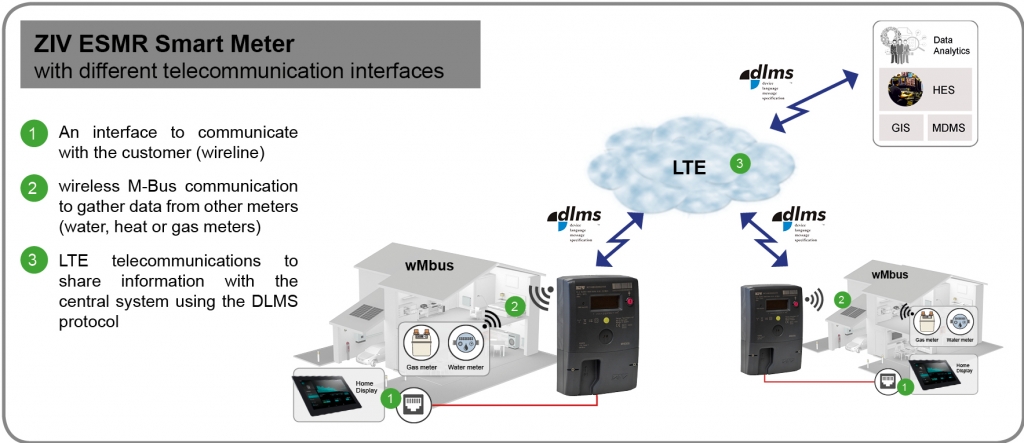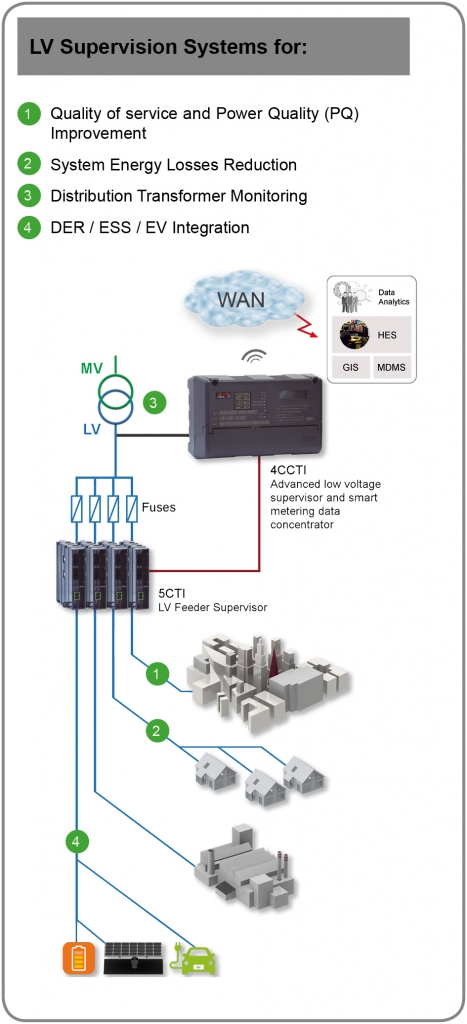Editorial By Aitor Amezua, ZIV Distribution Automation BU Development Manager
Smart electricity meters are a reality. Smart meters combine different technologies that range from
current/voltage measurements, energy and power calculations … to the integration of different telecommunication interfaces (powerline, wireless or wired communications).
A good example of the application of different telecommunication interfaces is the ESMR5 smart meter that ZIV is developing for Enexis.This smart meter integrates a wired interface to communicate with the customer, with wireless M-Bus communication (frequency range of 868Mhz) to collect data from other
meters in the vicinity (water, heat or gas meters). It integrates LTE telecommunications to share information with the central system using the DLMS protocol.

In all the countries that have decided to deploy smart meters, both customers and DNOs are achieving important benefits using this technology. Electricity customers can receive near real-time information
about their consumption, allowing them to implement energy efficiency policies.
Distribution network operators can gather data about their low voltage network which improves their grid visibility.
LV supervision, beyond AMI
Smart meter vendors have had to surmount many technological challenges in order to provide integrated advanced functions in a single meter device at a very competitive cost. The good news is that the technologies developed as a result of this effort have opened the door to a new family of products focused on LV grid operation.
In this article, we would like to highlight how LV grid visibility can be improved by adding LV smart devices at specific grid locations such as LV feeders and LV branches. These LV smart devices make use of the technology already available in smart meters to provide additional data so that distribution network operators have a clear view of the LV grid status and condition.
Operating the grid to improve quality of service
Continuity of supply is a must for DSOs/ DNOs, thus a reduction in the SAIFI and SAIDI figures is one of the indicators used to show performance improvement of the grid operators. Loads, such as electronic devices, appliances, inverters… which are sensitive to power disturbances are increasingly being connected to the grid. Consequently, the
measurement of power quality (PQ) parameters is becoming essential for network operators to
minimise the impact of voltage sags, swells or harmonics on a customer’s installation.
Continuously monitoring the LV grid enables early detection of power outages and power disturbances that may have an impact on a customer’s power quality. Status of blown fuses, loss of neutral and other events which are detected and reported to the network operator as soon as they occur, minimising
the interruption time.
Therefore, using these devices, which are available on the LV network to signal voltage outages by passing this information on to the network operator will allow action to be taken to reduce the interruption time. One step further is to automatically operate the grid combining the LV information with data provided by fault passage indicators and MV automation systems to restore the system
to a healthy state.
To take advantage of the possibilities provided by the new generation of smart devices and sensors connected to the LV grid and to obtain these data, they must be integrated into the utility operation systems. Utilities have reported a reduction of up to 70% in the SAIDI index for the 2001-2016
period with these improvements. Furthermore, up to 35% reduction in operational expenses per customer have also been achieved.
Improving efficiency, reducing losses
 Energy strategy for 2030 in the EU fixes a target of 27% energy savings compared to ‘business as usual’ figures. Meeting this target requires actions to improve the overall efficiency of the distribution networks. Energy losses have always been a concern for utilities. There is a direct economic impact
Energy strategy for 2030 in the EU fixes a target of 27% energy savings compared to ‘business as usual’ figures. Meeting this target requires actions to improve the overall efficiency of the distribution networks. Energy losses have always been a concern for utilities. There is a direct economic impact
on the business. Mandates of the EU and member states nails this figure down and formalises a commitment.
Technical losses, measurement errors and fraud detection require accurate and reliable
information on the flow of energy. The most frequently used method calculates the balance
between the energy delivered by a transformer or a feeder and the total energy metered in smart meters connected to the feeder or transformer. Resolution of the data and its mapping to the grid topology influence the accuracy of the results of the investigations.
Feeder monitoring produces high value information for LV grid operation and maintenance providing online updated network topology. This method avoids the cost of field work by the crews and
dramatically reduces the time required to update the information in the utility’s GIS. For power line carrier (PLC) enabled meters, ZIV has developed a technique for the identification of which smart meter
is connected to which LV feeder based on a measurement of the strength of the powerline communication signal received from each meter in the transformer substation. This technique produces excellent results in the field.
Efficiently managing network assets
Load imbalances among LV grid phases and/or feeders impacts efficiency because it prevents the full capacity of the system being exploited. The optimal load arrangement is therefore determined by combining smart meter data, feeder and transformer output measurements with network topology information. As a result of this optimisation, the life of the assets is prolonged, deferring investments in
unnecessary network extensions. Similarly, continuously monitoring MV/LV transformers provides data to determine the efficiency, usage factor, thermal stress and life expectancy. Based on this information,
DNOs can make decisions to extend the life of the transformer in a certain location, replace it with a smaller or bigger one, or install a new one with lower losses.
RES/DER, storage and EV integration
The EU has also stated in its 2030 energy strategy that there must be a target of at least 27% share of renewable energy consumption. Member states have subsequently adopted renewable energy
programmes to meet this requirement. Renewable energy connected to LV networks, especially in residential areas (urban or rural) cause effects for which the networks were not originally designed. Similarly, other distributed energy resources can also affect grid operation. New loads, such as electric
vehicles and storage, demand new solutions to be effectively integrated in the grid. LV supervision can be the cornerstone for the integration of new influences into the network and improve the quality of supply and service for every customer connected to the grid.
ZIV solution for LV supervision
The ZIV solution consists of two devices: the LV feeder supervisor (5CTI) and the LV controller (4CCTI).
The 5CTI feeder supervisors provide information to calculate energy losses in a transformer and LV feeder and compare this with average network losses to detect deviations, therefore indicating irregular
network performance. These particular locations are further investigated to determine whether the inefficiency is due to fraudulent consumer connections or poor performance of network components.
The 4CCTI LV controller is connected to the 5CTIs via a RS485 bus and provides valuable information such as power quality measurement, earth fault detection, fault recording and a meter-to-feeder
mapping algorithm which gives updated LV network topology information back to the network operator.
The solutions proposed in this article are based on AMI technologies successfully deployed all over Europe.
ZIV is participating in many of the major meter rollouts that are taking place in Europe and is a reliable partner to make your smart LV network a reality.
About ZIV LV supervision solutions

